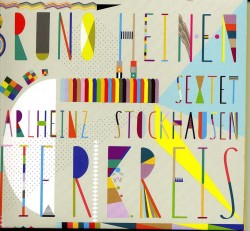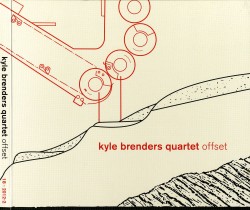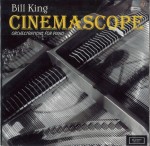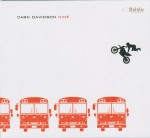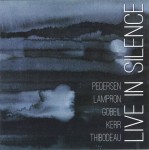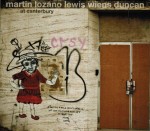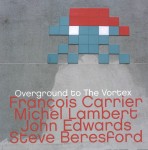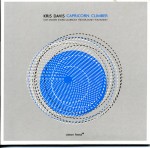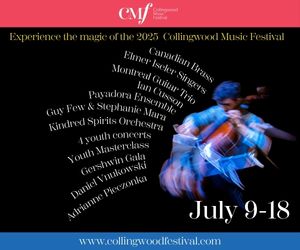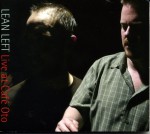 As the rhythmic base of jazz has changed over the past half century, adding emphases besides pure swing to improvisation, the role of the percussionist has changed as well. No longer just a time keeper the modern drummer must be conversant with varied beats from many genres of music. This familiarity with other cultures is also why many non-Americans have become prominent. Case in point is Norwegian percussionist Paal Nilssen-Love, who plays with the Euro-American band Lean Left at the Tranzac on June 15. Nilssen-Love, whose associates range from the most committed electronics dial-twister to free-form veterans is equally proficient laying down a hard rock-like beat as he is trading accents with experimental timbre-shatters. The two extended tracks on Live at Café Oto (Unsounds 32U www.unsounds.com) demonstrate not only Nilssen-Love’s cohesive skills amplifying the improvisations of Chicago-based tenor saxophonist/clarinettist Ken Vandermark as he does in many other contexts, but shows how both react to the power chords and violent string distortions which characterize the style of guitarists Andy Moor and Terrie Ex from Dutch punk band The Ex, who complete this quartet. In spite of Vandermark’s consistent overblowing which encompasses pumping altissimo honks and frenetic slurs; plus the guitarists’ constant crunches, smashes and frails, the drumming never degenerates into monotonous rock music-like banging. Instead, while the backbeat isn’t neglected, auxiliary clips, ruffs, ratamacues and smacks are used by Nilssen-Love to break up the rhythm, with carefully measured pulsations. This strategy is most obvious during the climatic sections of the more-than-37 minute Drevel. With all four Lean Lefters improvising in broken octaves, the narrative shakes to and fro between Vandermark’s collection of emphasized freak notes and dyspeptic stridency and the dual guitarists’ slurred fingering that leads to staccato twangs and jangling strums. Not only is the climax attained with a crescendo of volume and excitement, but the final theme variations are in contrast as stark and minimalist as the earlier ones are noisy. As guitars methodically clank as if reading a post-modern composition, and the clarinet lines emphasize atonal reed bites, intermittent stick strokes and toe-pedal pressure from the drummer concentrate the sound shards into the track’s calm finale.
As the rhythmic base of jazz has changed over the past half century, adding emphases besides pure swing to improvisation, the role of the percussionist has changed as well. No longer just a time keeper the modern drummer must be conversant with varied beats from many genres of music. This familiarity with other cultures is also why many non-Americans have become prominent. Case in point is Norwegian percussionist Paal Nilssen-Love, who plays with the Euro-American band Lean Left at the Tranzac on June 15. Nilssen-Love, whose associates range from the most committed electronics dial-twister to free-form veterans is equally proficient laying down a hard rock-like beat as he is trading accents with experimental timbre-shatters. The two extended tracks on Live at Café Oto (Unsounds 32U www.unsounds.com) demonstrate not only Nilssen-Love’s cohesive skills amplifying the improvisations of Chicago-based tenor saxophonist/clarinettist Ken Vandermark as he does in many other contexts, but shows how both react to the power chords and violent string distortions which characterize the style of guitarists Andy Moor and Terrie Ex from Dutch punk band The Ex, who complete this quartet. In spite of Vandermark’s consistent overblowing which encompasses pumping altissimo honks and frenetic slurs; plus the guitarists’ constant crunches, smashes and frails, the drumming never degenerates into monotonous rock music-like banging. Instead, while the backbeat isn’t neglected, auxiliary clips, ruffs, ratamacues and smacks are used by Nilssen-Love to break up the rhythm, with carefully measured pulsations. This strategy is most obvious during the climatic sections of the more-than-37 minute Drevel. With all four Lean Lefters improvising in broken octaves, the narrative shakes to and fro between Vandermark’s collection of emphasized freak notes and dyspeptic stridency and the dual guitarists’ slurred fingering that leads to staccato twangs and jangling strums. Not only is the climax attained with a crescendo of volume and excitement, but the final theme variations are in contrast as stark and minimalist as the earlier ones are noisy. As guitars methodically clank as if reading a post-modern composition, and the clarinet lines emphasize atonal reed bites, intermittent stick strokes and toe-pedal pressure from the drummer concentrate the sound shards into the track’s calm finale.
 An extension of this calm also eventually occurs on Double Tandem Cement (PNL Records PNL 013 www.paalnilssen-love.com), where Nilssen-Love’s and Vandermark’s only companion is Amsterdam’s Ab Baars, playing tenor saxophone, clarinet and shakuhachi. Although the drummer trots out ruffs, smacks and bounces when both saxophonists blare at top volume, the most distinctive track here is the 30-minute Shale. Dividing interaction into duos or trios, as he faces each reedist’s experiments in hushed atonality the percussionist limits himself to microtonal popping and ratcheting as if he were playing Native American drum patterns. When one tenor saxophonist expels Sonny Rollins-like sharp and brittle slurs and honks, Nilssen-Love concentrates his responses to cymbal swishes and snare splatters. Elsewhere, glockenspiel-like pings plus cross-handed ratamacues back lip-bubbling, mid-range clarinet growls. As eloquently precise as he is focused in his percussive responses, the drummer later limits himself to offside rim clattering and cymbal rubbing as his associates rappel through reed challenges. When Vandermark circular breathes strident clarinet tones, Baars’ shakuhachi puffs judder sympathetically. When one saxophonist explores the limits of altissimo bent notes, the other revels in penny-whistle-pitched chirps and squeaks. Eventually the apotheosis of pummelling split tones and forced glossolalia that the two attain subsides into tonal interaction confirming Nilssen-Love’s discreet accents throughout.
An extension of this calm also eventually occurs on Double Tandem Cement (PNL Records PNL 013 www.paalnilssen-love.com), where Nilssen-Love’s and Vandermark’s only companion is Amsterdam’s Ab Baars, playing tenor saxophone, clarinet and shakuhachi. Although the drummer trots out ruffs, smacks and bounces when both saxophonists blare at top volume, the most distinctive track here is the 30-minute Shale. Dividing interaction into duos or trios, as he faces each reedist’s experiments in hushed atonality the percussionist limits himself to microtonal popping and ratcheting as if he were playing Native American drum patterns. When one tenor saxophonist expels Sonny Rollins-like sharp and brittle slurs and honks, Nilssen-Love concentrates his responses to cymbal swishes and snare splatters. Elsewhere, glockenspiel-like pings plus cross-handed ratamacues back lip-bubbling, mid-range clarinet growls. As eloquently precise as he is focused in his percussive responses, the drummer later limits himself to offside rim clattering and cymbal rubbing as his associates rappel through reed challenges. When Vandermark circular breathes strident clarinet tones, Baars’ shakuhachi puffs judder sympathetically. When one saxophonist explores the limits of altissimo bent notes, the other revels in penny-whistle-pitched chirps and squeaks. Eventually the apotheosis of pummelling split tones and forced glossolalia that the two attain subsides into tonal interaction confirming Nilssen-Love’s discreet accents throughout.
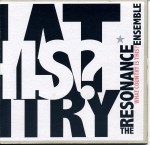 Vandermark confirms his far-reaching rhythmic sophistication and welcoming of worldwide improvisers on The Resonance Ensemble’s What Country is This? (NotTwo MW 885-2 www.nottwo.com). This is a program which balances his baritone saxophone and clarinet style plus the input from six additional horn players with the synergic percussion skills of two Chicago-based drummers, Tim Daisy and Michael Zerang. Veterans of many bands with Vandermark and others, both know exactly how to both lead and accompany an ensemble of American and Northern European players, including three more saxophonists, three brass players and one bassist. Tracks such as Fabric include rapidly changing pitch and speed sequences where, for instance, salient drum rolls from one percussionist and clattering rim shots from the other underline the inchoate power essayed by Vandermark’s baritone sax and Dave Rempis’ tenor saxophone, underlined by pedal-point blasts from Per Åke Holmlander’s tuba. By the finale shimmering cymbal and drum plops lessen the density and solidify a now well-balanced melody, leaving ample subsequent space for Devin Hoff’s walking bass solo, Magnus Broo’s plunger trumpet lines and mid-range clarinet sluices from Waclaw Zimpel. Stop-and-start rather than stop-time, the distinctive Acoustic Fence likewise mixes unique forms of expression from a swing-era-styled saxophone section riffing to a hearty tenor sax solo by Mikolaj Trzaska that’s just this side of rock music. Still the sinewy arrangement calls for the former to be accompanied by perfectly timed percussion slaps and clattering cymbals and the latter by tough shuffles and opposite sticking from the drummers that would be equally appropriate on a soul music session. Eventually, extended blustery trombone brays by Steve Swell prefigure the session’s only protracted percussion solos, as rolls, rumbles and ruffs open up into a restrained yet powerful display of thrusting textures and pinpointed smacks, with the narrative ricocheting from one drummer to the other.
Vandermark confirms his far-reaching rhythmic sophistication and welcoming of worldwide improvisers on The Resonance Ensemble’s What Country is This? (NotTwo MW 885-2 www.nottwo.com). This is a program which balances his baritone saxophone and clarinet style plus the input from six additional horn players with the synergic percussion skills of two Chicago-based drummers, Tim Daisy and Michael Zerang. Veterans of many bands with Vandermark and others, both know exactly how to both lead and accompany an ensemble of American and Northern European players, including three more saxophonists, three brass players and one bassist. Tracks such as Fabric include rapidly changing pitch and speed sequences where, for instance, salient drum rolls from one percussionist and clattering rim shots from the other underline the inchoate power essayed by Vandermark’s baritone sax and Dave Rempis’ tenor saxophone, underlined by pedal-point blasts from Per Åke Holmlander’s tuba. By the finale shimmering cymbal and drum plops lessen the density and solidify a now well-balanced melody, leaving ample subsequent space for Devin Hoff’s walking bass solo, Magnus Broo’s plunger trumpet lines and mid-range clarinet sluices from Waclaw Zimpel. Stop-and-start rather than stop-time, the distinctive Acoustic Fence likewise mixes unique forms of expression from a swing-era-styled saxophone section riffing to a hearty tenor sax solo by Mikolaj Trzaska that’s just this side of rock music. Still the sinewy arrangement calls for the former to be accompanied by perfectly timed percussion slaps and clattering cymbals and the latter by tough shuffles and opposite sticking from the drummers that would be equally appropriate on a soul music session. Eventually, extended blustery trombone brays by Steve Swell prefigure the session’s only protracted percussion solos, as rolls, rumbles and ruffs open up into a restrained yet powerful display of thrusting textures and pinpointed smacks, with the narrative ricocheting from one drummer to the other.
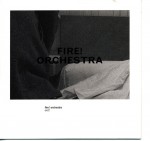 If that CD underlined the expressive power of two inventive percussionists then Fire! Orchestra Exit! (Rune Grammofon RDCD 2138 www.runegrammofon.com) ups the ante with four drummers contributing. Exit is a two-part multiphonic showcase for this massive band featuring 27 of Scandinavia’s top improvisers, including Holmlander and Broo; plus one ex-pat Canadian, bassist Joe Williamson. The ensemble is directed by tenor saxophonist Mats Gustafsson, a frequent associate of both Vandermark and Nilssen-Love, who played Toronto in May. Although part of the performance is devoted to wordless or unconnected phrase-making vocals from three singers – most prominently Sofia Jenberg – they’re part of the improving process, as their vocal cries, yodels and rasps intersect or soar over the often dense instrumental cacophony. While there’s never any doubt about the beat emanating in hearty unison from percussionists Raymond Strid, Andreas Werlin, Thomas Gartz and Johan Holmegard, like Nilssen-Love on Live at Café Oto, there’s sensitivity in their accompaniment. Designated space is also available for soloists who include Sten Sandell’s piano-pumping glissandi in addition to frenetic split tones and broken octave jumps from saxophonists Gustafsson and Frederick Ljungkvist. The percussionists shatter the finale of Exit! Part One with their collection of miscellaneous instruments of ratchets, rattles, gongs, bell trees and wood blocks. Then, if anything the CD’s second track is more intense and powerful than the first. It features string-shredding reverb from three guitarists, massed cadences from the vocalists, deep-pitched tuba burbling and a vamping reed section. Only as the piece reaches a fortissimo crescendo is it clear that the entire band has been steadily motivated by the drum quartet’s nearly inaudible clanks, clicks and drags, which have been present throughout. Eventually the harmonized percussionists’ conclusive thundering, echoing and booming make it clear the sonic miasma has been breached for the finale.
If that CD underlined the expressive power of two inventive percussionists then Fire! Orchestra Exit! (Rune Grammofon RDCD 2138 www.runegrammofon.com) ups the ante with four drummers contributing. Exit is a two-part multiphonic showcase for this massive band featuring 27 of Scandinavia’s top improvisers, including Holmlander and Broo; plus one ex-pat Canadian, bassist Joe Williamson. The ensemble is directed by tenor saxophonist Mats Gustafsson, a frequent associate of both Vandermark and Nilssen-Love, who played Toronto in May. Although part of the performance is devoted to wordless or unconnected phrase-making vocals from three singers – most prominently Sofia Jenberg – they’re part of the improving process, as their vocal cries, yodels and rasps intersect or soar over the often dense instrumental cacophony. While there’s never any doubt about the beat emanating in hearty unison from percussionists Raymond Strid, Andreas Werlin, Thomas Gartz and Johan Holmegard, like Nilssen-Love on Live at Café Oto, there’s sensitivity in their accompaniment. Designated space is also available for soloists who include Sten Sandell’s piano-pumping glissandi in addition to frenetic split tones and broken octave jumps from saxophonists Gustafsson and Frederick Ljungkvist. The percussionists shatter the finale of Exit! Part One with their collection of miscellaneous instruments of ratchets, rattles, gongs, bell trees and wood blocks. Then, if anything the CD’s second track is more intense and powerful than the first. It features string-shredding reverb from three guitarists, massed cadences from the vocalists, deep-pitched tuba burbling and a vamping reed section. Only as the piece reaches a fortissimo crescendo is it clear that the entire band has been steadily motivated by the drum quartet’s nearly inaudible clanks, clicks and drags, which have been present throughout. Eventually the harmonized percussionists’ conclusive thundering, echoing and booming make it clear the sonic miasma has been breached for the finale.
Hearty demonstrations of new percussionists’ taste as well as power, plus the ascendency of European musicians, these discs also suggest names to watch for when they next gig in Toronto.
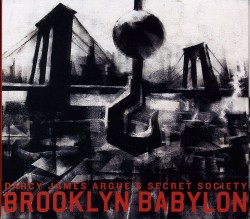 For an example of the latter you don’t have to go much further than Brooklyn Babylon (New Amsterdam Records NWAM 048 newamsterdamrecords.com), a mythical and cinematic narrative created by Vancouver-born Darcy James Argue as part of a multi-media presentation by Croatian-born visual artist Danijel Zezelj. Argue, who also lived in Montreal and received his degree in composition in Boston, has been in Brooklyn since 2003 and composed the multi-part Brooklyn Babylon as a fable, reflecting his adopted hometown’s storied past, cultural multiplicity and ambitious future. Conducted by the composer, Argue’s 18-piece Secret Society band performs the suite’s eight interlocking themes and seven brief interludes. Calling on the talents of a band featuring the interlocked groove of drummer Jon Wikan and bassist Matt Clohesy, the storytelling understatement of several reed soloists, and the alternately plunger excitement and mellow narratives of fellow Canuck trumpeter Ingrid Jensen, Argue directs a sound picture with enough expansive exposition to make the CD the equivalent of aural Technicolor. Reflecting present-day currents of New York`s second borough, the sequences in Argue’s suite blend and contrast vamping big-band section work; heavily rhythmic rock-music-like grooves; gentle folkloric and impressionistic sound pastels from flute, soprano sax and flugelhorn soloists; plus interludes that replicate brass band marches, Balkan ballads, a touch of electronic processing and the pre-recorded sounds of the borough’s streets. One standout is Missing Parts when the rest of the band members play hand percussion backing Josh Stinson’s free-form baritone sax lines and a mellow trombone interlude from James Hirschfield. Another is The Tallest Tower in the World, which reaches its heights through brassy trumpet triplets and soprano sax squeals. Keyboardist Gordon Webster holds components together not only with sharp piano cadenzas but also with near-vocalized melodic sweeps. If the program does have a weakness it probably lies in its movie soundtrack-like surround sound expressiveness. With piccolo peeps and French horn lowing heard more often than tuba burps or guitar note shredding, the selections often retreat to overly pleasant background sounds lacking the authoritative ingredients that would define them as completely individual. But Argue is still developing. Maybe he’ll soon compose a piece to reflect his homeland.
For an example of the latter you don’t have to go much further than Brooklyn Babylon (New Amsterdam Records NWAM 048 newamsterdamrecords.com), a mythical and cinematic narrative created by Vancouver-born Darcy James Argue as part of a multi-media presentation by Croatian-born visual artist Danijel Zezelj. Argue, who also lived in Montreal and received his degree in composition in Boston, has been in Brooklyn since 2003 and composed the multi-part Brooklyn Babylon as a fable, reflecting his adopted hometown’s storied past, cultural multiplicity and ambitious future. Conducted by the composer, Argue’s 18-piece Secret Society band performs the suite’s eight interlocking themes and seven brief interludes. Calling on the talents of a band featuring the interlocked groove of drummer Jon Wikan and bassist Matt Clohesy, the storytelling understatement of several reed soloists, and the alternately plunger excitement and mellow narratives of fellow Canuck trumpeter Ingrid Jensen, Argue directs a sound picture with enough expansive exposition to make the CD the equivalent of aural Technicolor. Reflecting present-day currents of New York`s second borough, the sequences in Argue’s suite blend and contrast vamping big-band section work; heavily rhythmic rock-music-like grooves; gentle folkloric and impressionistic sound pastels from flute, soprano sax and flugelhorn soloists; plus interludes that replicate brass band marches, Balkan ballads, a touch of electronic processing and the pre-recorded sounds of the borough’s streets. One standout is Missing Parts when the rest of the band members play hand percussion backing Josh Stinson’s free-form baritone sax lines and a mellow trombone interlude from James Hirschfield. Another is The Tallest Tower in the World, which reaches its heights through brassy trumpet triplets and soprano sax squeals. Keyboardist Gordon Webster holds components together not only with sharp piano cadenzas but also with near-vocalized melodic sweeps. If the program does have a weakness it probably lies in its movie soundtrack-like surround sound expressiveness. With piccolo peeps and French horn lowing heard more often than tuba burps or guitar note shredding, the selections often retreat to overly pleasant background sounds lacking the authoritative ingredients that would define them as completely individual. But Argue is still developing. Maybe he’ll soon compose a piece to reflect his homeland.

